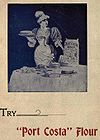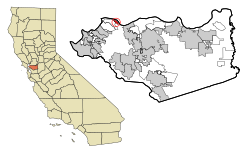Port Costa, California
Port Costa | |
|---|---|
 Heritage advertisement for Port Costa Flour | |
 Location in Contra Costa County and the state of California | |
 Port Costa Location in the United States | |
| Coordinates: 38°02′47″N 122°11′00″W / 38.04639°N 122.18333°WCoordinates: 38°02′47″N 122°11′00″W / 38.04639°N 122.18333°W | |
| Country | |
| State | |
| County | Contra Costa |
| Government | |
| • County Board | District V: |
| • State Senate | Bill Dodd (D)[1] |
| • State Assembly | Tim Grayson (D)[2] |
| • U. S. Congress | Mike Thompson (D)[3] |
| Area | |
| • Total | 0.158 sq mi (0.41 km2) |
| • Land | 0.158 sq mi (0.41 km2) |
| • Water | 0 sq mi (0 km2) 0% |
| Elevation | 16 ft (5 m) |
| Population (2010) | |
| • Total | 190 |
| • Density | 1,200/sq mi (460/km2) |
| Time zone | UTC-8 (PST) |
| • Summer (DST) | UTC-7 (PDT) |
| ZIP code | 94569 |
| Area code | 510, 341 |
| FIPS code | 06-58226 |
| GNIS feature IDs | 230948, 2409091 |
| [5] | |
Port Costa is a census-designated place (CDP) in Contra Costa County, California, United States. The population was 190 at the 2010 census.
Geography[]
According to the United States Census Bureau, the CDP has a total area of 0.16 square miles (0.41 km2), all of it land. Port Costa is surrounded by rolling hills grazed by cattle and managed by East Bay Regional Park District. Carquinez Strait Regional Shoreline stretches from Crockett through Port Costa and to Martinez. Big Bull Valley Creek runs along McEwen Road into a historic reservoir just above the town, then it runs in an underground pipe culvert beneath the town to the Carquinez Strait.[6]
History[]


Port Costa was founded in 1879 as a landing for the railroad ferry Solano, owned and operated by the Central Pacific Railroad.[7] This put Port Costa on the main route of the transcontinental railroad.[7] The Solano, later joined by the Contra Costa, carried entire trains across the Carquinez Strait from Benicia to Port Costa,[7] from whence they continued on to the Oakland Pier.[7] For a time, it was also the United States' busiest wheat-shipping port and had a reputation as a colorful, sometimes violent community.[citation needed]
After California's wheat output dropped in the early 20th century and especially after the Southern Pacific (which took over the operations of the Central Pacific) constructed a railroad bridge at Martinez in 1930 to replace the ferry crossing, Port Costa lost population and importance.[7] Bill Rich was an influential property owner and raconteur.[citation needed] Since the late 1960s, it has mainly been a small shopping venue for antique hunters and a gathering place for bikers and motorcyclists.
Port Costa's first post office was established in 1881.[8]
The town is unincorporated and has no official town government. There have however been unofficial “mayors.” The only official capacity of the title is to lead the Port Costa 4 July parade. Candidates have included dogs, toddlers, children and musicians. Elections are held whenever the mood strikes. There are no voting regulations and the whimsy of the event has become a fun tradition.
The Burlington Hotel was opened in 1883 and has a rich history. It is still debated as to whether or not it was actually a brothel in the olden days.
Demographics[]
The 2010 United States Census[9] reported that Port Costa had a population of 190. The population density was 1,200.1 people per square mile (463.3/km2). The racial makeup of Port Costa was 172 (90.5%) White, 2 (1.1%) African American, 2 (1.1%) Native American, 7 (3.7%) Asian, and 7 (3.7%) from two or more races. Hispanic or Latino of any race were 10 persons (5.3%).
There were 99 households, out of which 15 (15.2%) had children under the age of 18 living in them, 37 (37.4%) were opposite-sex married couples living together, 4 (4.0%) had a female householder with no husband present, 5 (5.1%) had a male householder with no wife present. There were 10 (10.1%) unmarried opposite-sex partnerships, and 3 (3.0%) same-sex married couples or partnerships. 42 households (42.4%) were made up of individuals, and 9 (9.1%) had someone living alone who was 65 years of age or older. The average household size was 1.92. There were 46 families (46.5% of all households); the average family size was 2.61.
The population was spread out, with 19 people (10.0%) under the age of 18, 13 people (6.8%) aged 18 to 24, 38 people (20.0%) aged 25 to 44, 80 people (42.1%) aged 45 to 64, and 40 people (21.1%) who were 65 years of age or older. The median age was 52.5 years. For every 100 females, there were 97.9 males. For every 100 females age 18 and over, there were 101.2 males.
There were 110 housing units at an average density of 694.8 per square mile (268.3/km2), of which 99 were occupied, of which 53 (53.5%) were owner-occupied, and 46 (46.5%) were occupied by renters. The homeowner vacancy rate was 5.4%; the rental vacancy rate was 2.1%. 118 people (62.1% of the population) lived in owner-occupied housing units and 72 people (37.9%) lived in rental housing units.
See also[]
![]() California portal
California portal
References[]
- ^ "Senators". State of California. Retrieved April 1, 2013.
- ^ "Members Assembly". State of California. Retrieved April 1, 2013.
- ^ "California's 5th Congressional District - Representatives & District Map". Civic Impulse, LLC. Retrieved March 9, 2013.
- ^ "2010 Census U.S. Gazetteer Files – Places – California". United States Census Bureau.
- ^ Jump up to: a b "Port Costa". Geographic Names Information System. United States Geological Survey.
- ^ U.S. Geological Survey Geographic Names Information System: Big Bull Valley
- ^ Jump up to: a b c d e Images of America: Richmond, by Donald Bastin, Arcadia Publishing (SC), November 2003
- ^ Durham, David L. (1998). California's Geographic Names: A Gazetteer of Historic and Modern Names of the State. Clovis, Calif.: Word Dancer Press. p. 684. ISBN 1-884995-14-4.
- ^ "2010 Census Interactive Population Search: CA - Port Costa CDP". U.S. Census Bureau. Archived from the original on July 15, 2014. Retrieved July 12, 2014.
External links[]
![]() Media related to Port Costa, California at Wikimedia Commons
Media related to Port Costa, California at Wikimedia Commons
- Census-designated places in Contra Costa County, California
- Carquinez Strait
- Populated places established in 1879
- 1879 establishments in California
- Census-designated places in California


